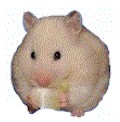If you are considering adopting a dwarf hamster, you're in for a fun and gratifying experience. But before you open your heart and home to one of these warm and beguiling creatures, you should consider carefully what is required to care for these furry little critters that are sometimes called "pocket pets".
Dwarf hamsters are much littler than their common cousins, the Syrian or Golden Hamster, which are usually about 8 inches long. Depending on the species, dwarf hamsters range from 2 to 4 inches long and vary in color and appearance.
For example, the Siberian hamster, also known as the Winter White Russian Hamster, can change color from gray to white during the winter months. Whereas the Chinese hamster is often described as looking like a mouse, partially because it has a tail.
Don't assume that little size means little care. Hamsters need just as much love and attention as any other pet. In some ways, more.
Dwarf hamsters are very lively and can be quite delicate. They are also quite agile and swift. And because they are so little, they are able to squeeze into seemingly impossible spaces. so, unless your intention is to let your new pet roam free (and possibly nest in your linen closet), you need to be certain that you have provided them with an "escape-proof" cage.
The Best Cage for Your Dwarf HamsterBefore they became domesticated, hamsters lived in a labyrinth of burrows or tunnels dug into the dirt and sand. For this reason, they feel most comfy in the plastic cages that can accommodate a series of running tubes.
Keep in mind, however, that the ones made for the common hamster are too big for your small friend. He'll need some form of assistance to navigate the connecting tunnels. Something like a small branch would work well.
Additionally, it is possible to purchase a plastic cage that is made specifically for mice and dwarf hamsters. These are perfect for your diminutive friend.
If the plastic cages cost more than you are ready to spend, you might consider a ten or twenty gallon aquarium. Steer clear of wire cages. (Unless, of course, you think it would be fun to play hide and seek with your hamster - throughout your entire home!) However, if you are dead set on a wire cage, please choose one with the smallest gauge wire available.
Additional Supplies for Setting Up a Cozy HomeYour choice of bedding material is more important than you might expect. Look for one that is absorbent, dust-free and will indulge your pet's natural burrowing instinct, like wood shavings or pelleted litter. But please don't use products made with pine or cedar. Both can possibly irritate your dwarf hamster's respiratory system.
It is also important to change the litter at least once every week. And while you're at it, it's a good idea to wash his cage thoroughly with a mild soap and water solution. Strong chemical cleansers should be strictly avoided. Be sure to rinse it well and dry completely before adding the fresh bedding.
By nature, dwarf hamsters are very private creatures. So be sure to indulge your furry friend by supplying him with a cozy place to retreat - a nesting box or other suitable "hidey hole". You'll also want to provide some materials with which he can make a nest. Shredded paper, paper towels or tissues are good choices. Your pet will build a nice little fluffy retreat for himself where he can while away the daylight hours.
You should resist the urge to roust him out to play when he's in his nest. Disturbing him during his private time will cause him undue stress which could lead to a cranky and sickly hamster.
Dwarf Hamster FoodEven though they're little, dwarf hamsters eat every bit as much as their larger cousins. Their diet should consist primarily of a commercially prepared hamster seed mix. You can supplement this with occasional snacks of greens, raw vegetables and nuts or seeds, like sunflower seeds.
It is absolutely essential that you avoid feeding your pet sweets or candy. More than one hamster owner has discovered, much to their dismay, that "surprising" their precious pet with a sugary treat can be deadly.
Hoarding food is a natural behavior for hamsters and is not a cause for concern. But, even though your pet may have several stashes of food hidden away in various places throughout his cage, fresh food and water should be given daily. Be meticulous about removing his food caches when changing the bedding.
Recommended AccessoriesAn exercise wheel is a must. Hamsters are hard-wired to be very energetic. In fact, research indicates that it is not unusual for them to log as much as 5 miles each night. A wheel that is smaller than the traditional variety and has a continuous surface running is best. If you must get one with rungs, look for one with minimal space between them. Widely spaced rungs may cause your furry little friend to constantly lose his footing and possibly injure himself.
In order to keep his teeth trimmed, your hamster needs to chew. Not providing proper chew toys could prove to be detrimental to his health because your hamster's teeth are constantly growing. Chewing is a natural, albeit a bit obsessive, behavior with hamsters. So be sure that he has some soft wooden toys to gnaw on. If you don't, he will find something less desirable - and perhaps injurious - to satisfy this instinctual need.
As you can see, caring for a dwarf hamster does require a commitment of your time and a little work, but you will find that the delight experienced when interacting with and observing your tiny "pocket pet" far outweighs any effort involved.
